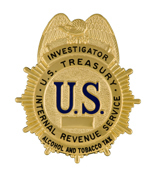Bootleggers, Moonshiners and Violent Crime

In 1952, the Internal Revenue Service consolidated the internal enforcement responsibilities of alcohol and tobacco under one unit, which became known as the Alcohol and Tobacco Tax Division.
Pursuing illegal liquor operations proved to be hazardous work. From 1934 through the 1960s, 17 investigators were killed, and hundreds were injured in gunfire, assault by violators, and high-speed automobile chases.
Campaign Against Sugar

Moonshiners posed their own set of challenges. These small, independent distillers operated outside syndicate groups and supplied whiskey primarily to local populations.
The 1950s “Preventative Raw Materials Program” allowed agents to arrest moonshiners for possession of large quantities of sugar. A parallel campaign urged merchants to deny bulk sugar supplies to suspicious persons.
Moonshine Kills

Moonshine’s poisonous punch is reflected in its nicknames: “white lightning,” “head-buster” and “popskull.” A Georgia agent observed that, “Illicit producers sometimes add manure to make moonshine ferment faster, and we’ve found dead possums, rats and vermin floating in mash vats.” Moonshine-related deaths were so widespread in the 1960s, a government- funded public service announcement campaign was launched.
Assassinations and Gun Control
The passage of Title IV of the Omnibus Crime Control Act, and the Gun Control Act (GCA) of 1968, resulted from the assassinations of President John Kennedy, Senator Robert Kennedy and civil rights activist Dr. Martin Luther King, Jr. The GCA imposed stricter licensing and regulation of the firearms industry, established new categories of firearms offenses and prohibited the sale of firearms and ammunition to felons and certain other prohibited persons.



